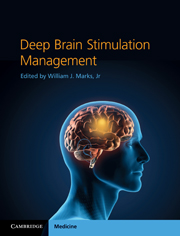Book contents
- Deep Brain Stimulation Management
- Deep Brain Stimulation Management
- Copyright page
- Dedication
- Contents
- Contributors
- Preface
- Chapter 1 Introduction
- Chapter 2 Patient selection
- Chapter 3 Surgical placement of deep brain stimulation leads for the treatment of movement disorders: intraoperative aspects
- Chapter 4 Principles of neurostimulation
- Chapter 5 Fundamentals of deep brain stimulation programming
- Chapter 6 Managing essential tremor patients treated with deep brain stimulation
- Chapter 7 Managing Parkinson's disease patients treated with deep brain stimulation
- Chapter 8 Managing dystonia patients treated with deep brain stimulation
- Chapter 9 Assessing patient outcome and troubleshooting deep brain stimulation
- Chapter 10 Implementing deep brain stimulation into practice
- Appendix A: Motor diary
- Appendix B: Unified Parkinson's Disease Rating Scale
- Appendix C: Abnormal Involuntary Movement Scale
- Appendix D: PDQ-39 questionnaire
- Appendix E: Montreal Cognitive Assessment Test – English
- Appendix F: Geriatric Depression Scale
- Appendix G: Burke–Fahn–Marsden Dystonia Rating Scale
- Appendix H: Toronto Western Spasmodic Torticollis Rating Scale
- Appendix I: GPi DBS programming data sheet
- Appendix J: STN DBS programming data sheet
- Appendix K: Vim DBS programming data sheet
- Appendix L: DBS programming tracking form
- Appendix M: Tremor Rating Scale
- Index
Chapter 1 - Introduction
The expanding role of deep brain stimulation
Published online by Cambridge University Press: 10 November 2010
- Deep Brain Stimulation Management
- Deep Brain Stimulation Management
- Copyright page
- Dedication
- Contents
- Contributors
- Preface
- Chapter 1 Introduction
- Chapter 2 Patient selection
- Chapter 3 Surgical placement of deep brain stimulation leads for the treatment of movement disorders: intraoperative aspects
- Chapter 4 Principles of neurostimulation
- Chapter 5 Fundamentals of deep brain stimulation programming
- Chapter 6 Managing essential tremor patients treated with deep brain stimulation
- Chapter 7 Managing Parkinson's disease patients treated with deep brain stimulation
- Chapter 8 Managing dystonia patients treated with deep brain stimulation
- Chapter 9 Assessing patient outcome and troubleshooting deep brain stimulation
- Chapter 10 Implementing deep brain stimulation into practice
- Appendix A: Motor diary
- Appendix B: Unified Parkinson's Disease Rating Scale
- Appendix C: Abnormal Involuntary Movement Scale
- Appendix D: PDQ-39 questionnaire
- Appendix E: Montreal Cognitive Assessment Test – English
- Appendix F: Geriatric Depression Scale
- Appendix G: Burke–Fahn–Marsden Dystonia Rating Scale
- Appendix H: Toronto Western Spasmodic Torticollis Rating Scale
- Appendix I: GPi DBS programming data sheet
- Appendix J: STN DBS programming data sheet
- Appendix K: Vim DBS programming data sheet
- Appendix L: DBS programming tracking form
- Appendix M: Tremor Rating Scale
- Index
Summary
- Type
- Chapter
- Information
- Deep Brain Stimulation Management , pp. 1 - 3Publisher: Cambridge University PressPrint publication year: 2010
- 1
- Cited by



